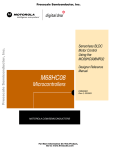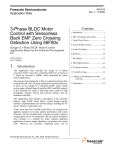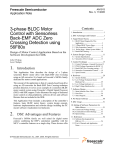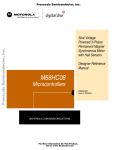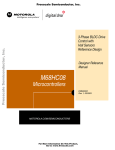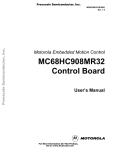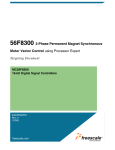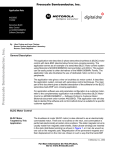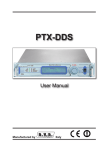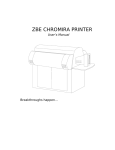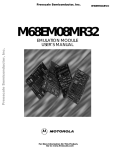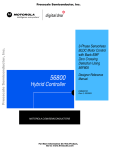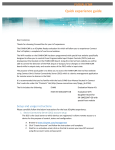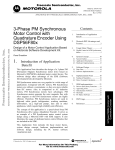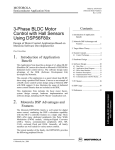Download Sensorless BLDC Motor Control on MC68HC908MR32 Software
Transcript
Freescale Semiconductor Application Note AN2356/D 11/2002 Freescale Semiconductor, Inc... Sensorless BLDC Motor Control on MC68HC908MR32 Software Porting to Customer Motor By Libor Prokop and Leos Chalupa Roznov System Application Laboratory Roznov, Czech Republic General Description This application note describes using the software for 3-phase sensorless brushless dc motor (BLDC) control with back-EMF zero crossing. The software is designed for Motorola’s MC68HC908MR32 microcontroller unit (MCU) and dedicated for motor control; however, it could be easily ported to other derivatives of the MC68HC(9)08MRx Family. This application note serves as a guide for application software use and parameter configuration for a customer motor. It also helps to decide if the software and control method is suitable for the specific customer application. For a more detailed view of brushless dc motor control, application system concepts, control techniques, and software description refer to the complementary application note entitled Sensorless BLDC Motor Control on MC68HC908MR32 — Software Description (Freescale document order number AN2355/D). System Concept The application block diagram is shown in Figure 1. The sensorless rotor position technique detects the zero crossing points of back-EMF induced in the motor windings. The phase back-EMF zero crossing points are sensed while one of the three phase windings is not powered. The information obtained is processed in order to commutate the energized phase pair and control the phase voltage, using pulse width modulation. The back-EMF zero crossing detection enables position recognition. The resistor network is used to step down sensed voltages to a 0–3.3 V level. Zero crossing detection is synchronized with the middle of center aligned PWM signals by the software, in order to filter high voltage spikes produced by switching the IGBTs (MOSFETs). The software selects by MUX command the phase comparator output that corresponds to the current commutation step. The multiplexer (MUX) circuit selects this signal, which is then transferred to the MCU input. © Freescale Semiconductor, Inc., 2004. All rights reserved. Freescale Semiconductor, Inc. AN2356/D Three-Phase Inverter DC Bus Current & DC Bus Voltage Sensing Power line 3-ph BLDC Motor 3 BEMF Voltage Zero Crossing Comparators 3 phase BLDC Power Stage Freescale Semiconductor, Inc... MUX DC-Bus Voltage/ Current Temperature BEMF Zero Crossing signal Digital Inputs ADC Zero Crossing PC Master SCI MUX Command Digital Outputs PWM Generator with Dead Time Zero Crossing Time moment Zero Crossing Period, Position Recognition PWM Commutation Control Duty Cycle Commutation Period 1/T START STOP Actual Speed Required Speed Speed PI Regulator SPEED Required Alignment Current Actual Current Current PI Regulator (for Alignment) HC08MR32 Figure 1. System Concept The voltage drop resistor is used to measure the dc-bus current which is chopped by the pulse-width modulator (PWM). The signal obtained is rectified and amplified (0–3.3 V with 1.65 V offset). The internal MCU analog-to-digital (A/D) converter and zero crossing detection are synchronized with the PWM signal. This synchronization avoids spikes when the IGBTs (or MOSFETs) are switched and simplifies the electric circuit. Sensorless BLDC Motor Control on MC68HC908MR32 2 Software Porting to Customer Motor For More Information On This Product, Go to: www.freescale.com Freescale Semiconductor, Inc. AN2356/D Drive Specification During the rotor alignment state, the dc-bus current is controlled by the current PI regulator. In the other states (motor running), the phase voltage (PWM duty cycle) is controlled by the speed PI regulator. The A/D converter is also used to sense the dc-bus voltage and the drive temperature. The dc-bus voltage is stepped down to a 3.3-V signal level by a resistor network. Freescale Semiconductor, Inc... The six IGBTs (copack with built-in fly back diode), or MOSFETs, and gate drivers create a compact power stage. The drivers provide the level shifting that is required to drive the high side switch. The PWM technique is used to control motor phase voltage. Drive Specification The concept of the application is that of a speed-closed loop drive using back-EMF zero crossing technique for position detection. It serves as an example of a sensorless BLDC motor control system using Motorola’s MC68HC908MR32 MCU. It also illustrates the usage of dedicated motor control on-chip peripherals. The system for BLDC motor control consists of hardware and software. The application uses universal modular motion control development hardware boards, which are provided by Freescale for customer development support. For a description of these hardware boards refer to References 3., 4., 5., 6., 7., and the World Wide Web at: http://www.freescale.com There are three board and motor hardware sets for the application: 1. High-Voltage Hardware Set — For variable line voltage 115–230 Vac and medium power (phase current < 2.93 A) 2. Low-Voltage Evaluation Motor Hardware Set — For automotive voltage (12 V) and very low power (phase current < 4 A) 3. Low-Voltage Hardware Set — For automotive voltage (12 V or possibly 42 V) and medium power (phase current < 50 A) Software Specification The application software is practically the same for all three hardware platforms. The only modification needed is to include one of three constants that customize the hardware and motor parameter settings. The software (written in C language) specifications are listed in Table 1. A useful feature of the software is serial communication with PC master software protocol via RS232. The PC master software is PC computer software which allows reading and setting of all the system variables, and can also run html script pages to control the application from the PC. Another feature of the BLDC control software, is on-line parameter modification with PC master software, which can be used for software parameter tuning to a customer motor. Sensorless BLDC Motor Control on MC68HC908MR32 Software Porting to Customer Motor For More Information On This Product, Go to: www.freescale.com 3 Freescale Semiconductor, Inc. AN2356/D . Table 1. Software Specifications Control Algorithm 3-phase trapezoidal BLDC motor control star or delta! connected Sensorless, with back-EMF zero crossing commutation control Speed closed loop control Motoring mode Target Processor C-language with some arithmetical functions in assembler Compiler Metrowerks ANSI-C/cC++ Compiler for HC08 Application Control Freescale Semiconductor, Inc... MC68HC908MR32 Language Manual interface (start/stop switch, speed potentiometer control, LED indication) PC master software (remote) interface (via RS232 using PC computer) MCU Oscillator Frequency 4 MHz (with default software setting) MCU Bus Frequency 8 MHz (with default software setting) Minimal BLDC Motor Commutation Period (Without PC Master Software Communication) 333 µs (with default software setting and COEF_HLFCMT = 0.450) Minimal BLDC Motor Commutation Period (with PC Master Software Control) 520 µs (with default software setting and COEF_HLFCMT = 0.450) Targeted Hardware Software is prepared to run on three optional board and motor hardware sets: • High-voltage hardware set at variable line voltage 115–230 Vac (software customizing file const_cust_hv.h) • Low-voltage evaluation motor hardware set (software customizing file const_cust_evmm.h) • Low-voltage hardware set (software customizing file const_cust_lv.h) Software Configuration and Parameters Setting Configuration to one of the three required hardware sets is provided by inclusion of dedicated software customizing files. The software pack contains the files const_cust_hv.h, const_cust_lv.h, and const_cust_evm.h with predefined parameter settings for running on one of the optional board and motor hardware sets. The required hardware must be selected in code_fun.c file by one of these files #include. Where software is configuration for different customer motors, the software configuration for any motor is provided in the dedicated customizing file, according to the hardware board used. PWM frequency 15.626 kHz with default software setting, possibly changeable in const.h file Sensorless BLDC Motor Control on MC68HC908MR32 4 Software Porting to Customer Motor For More Information On This Product, Go to: www.freescale.com Freescale Semiconductor, Inc. AN2356/D Drive Specification Hardware and Drive Specifications The other system specifications are determined by hardware boards and motor characteristics. The boards and their connections are shown in Hardware Configuration. The hardware set specifications are discussed in the following subsections. High-Voltage Hardware Set Specification This hardware set is dedicated for medium power (phase current < 2.93 A) and main voltage. The specifications for a high-voltage hardware and motor set are listed in Table 2. The hardware operates on both 230 Vac and 115 Vac mains. Freescale Semiconductor, Inc... Table 2. High Voltage Hardware Set Specifications Hardware Boards Characteristics Motor Characteristics Input voltage: Maximum dc-bus voltage: 407 V Maximal output current: 2.93A Motor type: Speed range: Maximum electrical power: Drive Characteristics 230 Vac or 115 Vac 6 poles, three phase, star connected, BLDC motor, EM Brno SM40V 2500 rpm (at 310 V) 150 W Phase voltage: 3*220 V Phase current: 0.55 A Speed range: Maximum dc-bus voltage: Optoisolation: Protection: Load Characteristic Type: < 2500 rpm (determined by motor used) 380 V Required Over-current, over-voltage, and under-voltage fault protection Varying Sensorless BLDC Motor Control on MC68HC908MR32 Software Porting to Customer Motor For More Information On This Product, Go to: www.freescale.com 5 Freescale Semiconductor, Inc. AN2356/D Low-Voltage Evaluation Hardware Set Specification This hardware set is dedicated for 12 V voltage and very low power (phase current < 4 A). The specifications for a low-voltage evaluation hardware and motor set are listed in Table 3. It is targeted first of all to software evaluation with small motors. Table 3. Low Voltage Evaluation Hardware Set Specifications Hardware Boards Characteristics Input voltage: 12 Vdc Maximum dc-bus voltage: 16.0 V Maximal output current: Freescale Semiconductor, Inc... Motor Characteristics Motor type: Speed range: Maximal line voltage: Drive Characteristics 4 poles, three phase, star connected, BLDC motor < 5000 rpm (at 60 V) 60 V Phase current: 2A Output torque: 0.140 Nm (at 2 A) Speed range: < 1400 rpm Input voltage: 12 Vdc Maximum dc-bus voltage: 15.8 V Protection: Load Characteristic Type: Sensorless BLDC Motor Control on MC68HC908MR32 6 4.0 A Software Porting to Customer Motor For More Information On This Product, Go to: www.freescale.com Over-current, over-voltage, and under-voltage fault protection Varying Freescale Semiconductor, Inc. AN2356/D Drive Specification Low-Voltage Hardware Set Specification This hardware set is dedicated for medium power (phase current < 50 A) and automotive voltage. The specifications for a low-voltage hardware and motor set are listed in Table 4. The hardware power stage board is dedicated for 12 V, but can be simply configured to a 42 V supply (described in documentation for the ECLOVACBLDC board). The supplied motor is targeted for 12 V. Table 4. Low Voltage Hardware Set Specifications Freescale Semiconductor, Inc... Hardware Boards Characteristics Input voltage: Maximum dc-bus voltage: Maximal output current: Motor Characteristics Motor type: Speed range: Maximum electrical power: Drive Characteristics 12 Vdc or 42 V 16.0 V or 55.0 V 50.0 A 6 poles, three phase, star connected, BLDC motor, EM Brno SM40N 3000 rpm (at 12 V) 150 W Phase voltage: 3*6.5 V Phase current: 17 A Speed range: < 2500 rpm Input voltage: 12 Vdc Maximum dc-bus voltage: 15.8 V Protection: Load Characteristic Type: Over-current, over-voltage, and under-voltage fault protection Varying Sensorless BLDC Motor Control on MC68HC908MR32 Software Porting to Customer Motor For More Information On This Product, Go to: www.freescale.com 7 Freescale Semiconductor, Inc. AN2356/D Software Suitability Guide for Customer Application and Motor Freescale Semiconductor, Inc... Minimal Application Speed As it is known, the back-EMF voltage is proportionally dependent on motor speed. Since the sensorless back-EMF zero crossing sensing technique is based on back-EMF voltage, it has some minimal speed limitations! The motor start-up is solved by starting (back-EMF acquisition) state, but minimal operation speed is limited. The minimal speed depends on many factors of the motor and hardware design, and differs for any application. This is because the back-EMF zero crossing is disturbed and effected by the zero crossing comparator threshold as explained below and in the Effect of Mutual Inductance and Effect of Mutual Phase Capacitance sections of the complementary application note entitled Sensorless BLDC Motor Control on MC68HC908MR32 — Software Description Freescale document order number AN2355/D). NOTE: Maximal Application Speed Usually, the minimal speed for reliable operation is from 7% to 20% of the motor’s nominal speed. The maximal motor speed is limited by the minimal commutation period: 6 60 ( 10 ) maximal speed[rpm] = -------------------------------------------------------------------------------------------------------------------------- Equation 1 min. commutation period [us]*COMMUT_REV COMMUT_REV — commutations per motor revolution, must be set according to rotor poles: 6p COMMUT_REV = ------2 Equation 2 where: p = rotor poles The minimal commutation period is determined by execution time of the software. With default software settings and COEF_HLFCMT = 0.450 it is 333 µs, as shown in Table 1. So for example, the 4 pole (3-phase) motor can be controlled up to the maximal speed of 15,015 rpm. NOTE: Voltage Close Loop Using PC master software in the application increases the minimal commutation time. This is due to the execution of PC master software routine. In this case, the minimal execution time is 520 ms. The minimal commutation period could be decreased using pure assembler code instead of C coding. As shown in Application Hardware and Software Configuration, the speed control is based on voltage close loop control. This should be sufficient for most applications. Sensorless BLDC Motor Control on MC68HC908MR32 8 Software Porting to Customer Motor For More Information On This Product, Go to: www.freescale.com Freescale Semiconductor, Inc. Freescale Semiconductor, Inc... AN2356/D Software Suitability Guide for Customer Application and Motor Motor Suitability Back-EMF zero crossing sensing is achievable for most of BLDC motors with a trapezoidal back-EMF. However, for some BLDC motors the back-EMF zero crossing sensing can be problematic since it is affected by unbalanced mutual phase capacitance and inductance. It can disqualify some motors from using sensorless techniques based on the back-EMF sensing. Effect of Mutual Phase Capacitance As described in the complementary application note entitled Sensorless BLDC Motor Control on MC68HC908MR32 — Software Description (Freescale document order number AN2355/D), the mutual phase capacitances play an important role in the back-EMF sensing. Usually the mutual capacitance is very small. Its influence is only significant during the PWM switching when the system experiences very high du/dt.The effect of mutual capacitance is shown in Figure 2. Channel 1 shows an example of the disturbed “branch” voltage caused by unbalanced mutual capacitance. The other phase (channel 2) is not affected because it faces balanced mutual capacitance. An important conclusion from the complementary application note entitled Sensorless BLDC Motor Control on MC68HC908MR32 — Software Description (Freescale document order number AN2355/D) is the fact that only the unbalance of the mutual capacitance (not the capacitance itself) disturbs the back-EMF sensing! With both capacities equal (they are balanced) the disturbances disappear. Figure 2. Disturbed Back-EMF by Unbalanced Capacity Coupling Sensorless BLDC Motor Control on MC68HC908MR32 Software Porting to Customer Motor For More Information On This Product, Go to: www.freescale.com 9 Freescale Semiconductor, Inc. AN2356/D NOTE: Note that the configuration of the end-turns of the phase windings has a significant impact. Therefore, it must be properly managed to preserve the balance of the mutual capacity. This is especially important for prototype motors that are usually hand-wound. Channel 1 in Figure 2 shows an example of the disturbed “branch” voltage which can cause impossible back-EMF zero crossing sensing. Freescale Semiconductor, Inc... CAUTION: Effect of Mutual Inductance Failing to maintain balance of the mutual capacitance can easily disqualify such motors from using sensorless techniques based on the back-EMF sensing. Usually the BLDC motors with windings wound on separate poles show minor presence of the mutual capacitance. Thus, the disturbance is insignificant. The negative effect on back-EMF sensing of mutual inductance, is not to such a degree as unbalanced mutual capacitance. However, it can be noticed on the sensed phase. The difference of the mutual inductances between the coils which carry the phase current and the coil used for back-EMF sensing, causes the PWM pulses to be superimposed onto the detected back-EMF voltage. Figure 3 shows the real measured “branch” voltage. The red curves highlight the effect of the difference of the mutual inductances. This difference is not constant. 0V Figure 3. Mutual Inductance Effect Due to the construction of the BLDC motor, both mutual inductances vary and they are equal at the position that corresponds to the back-EMF zero crossing detection. NOTE: CAUTION: The BLDC motor with stator windings distributed in the slots has technically higher mutual inductances than other types. Therefore, this effect is more significant. On the other hand, the BLDC motor with windings wound on separate poles, shows minor presence of the effect of mutual inductance. However noticeable this effect, it does not degrade the back-EMF zero crossing detection, because it is cancelled at the zero crossing point. Additional simple filtering helps to reduce ripples further. Sensorless BLDC Motor Control on MC68HC908MR32 10 Software Porting to Customer Motor For More Information On This Product, Go to: www.freescale.com Freescale Semiconductor, Inc. AN2356/D Application Hardware and Software Configuration Application Hardware and Software Configuration Freescale Semiconductor, Inc... Hardware Configuration As mentioned, the software can be configured to run on one of the three hardware and motor platforms: • High-Voltage Hardware Set Configuration • Low-Voltage Evaluation Motor Hardware Set Configuration • Low-Voltage Hardware Set Configuration The hardware setups are shown in Figure 4, Figure 5, and Figure 6. These setups are described in following subsections (see Hardware and Drive Specifications for each platform characteristics). The supplied controller boards for MC68HC908MR32 (ECCTRMR32) allows two possibilities for software execution: 1. MMDS Evaluation Board (KITMMDSMR32) Using a real-time debugger (supplied with the Metrowerks compiler) the evaluation board is connected to the controller board (ECCTRMR32) via an emulator connector. This solution is recommended for software evaluation. 2. Programmed MCU (MC68HC908MR32) Where a daughter board module, with MC68HC908MR32 processor, is plugged into the controller board (ECCTRMR32) instead of the emulator cable, the processor must be programmed in an external programmer. This solution is recommended for demonstration purposes and final tests. Figure 4, Figure 5, and Figure 6 show the configuration with MMDS evaluation board. NOTE: A detailed description of the individual boards can be found in comprehensive user’s manuals belonging to each board (see References 3., 4., 5., 6., 7., 8.). Each user’s manual incorporates the schematic of the board, description of individual function blocks, and bill of materials. The individual boards can be ordered from Freescale as a standard product. Sensorless BLDC Motor Control on MC68HC908MR32 Software Porting to Customer Motor For More Information On This Product, Go to: www.freescale.com 11 Freescale Semiconductor, Inc. AN2356/D High-Voltage Hardware Set Configuration The system configuration for a high-voltage hardware set is shown in Figure 4. +12VDC PC Computer RS232 PC Master GND 40w flat ribbon cable U2 L J11.1 J11.2 PE 3ph AC/BLDC High Voltage Power Stage J14 J1 40w flat ribbon cable U1 JP1.1 JP1.2 Optoisolation Board J2 ECOPT 100 - 240VAC 49 - 61 Hz J5 Controller Board HC908MR32 ECCTR908MR32 J13.1 J13.2 J13.3 MB1 Black White Red Motor-Brake SM40V SG40N EVM1 ECOPTHIVACBLDC KITMMDS08MR32 Not Connected Black White J5 Red Freescale Semiconductor, Inc... N U3 ECMTRHIVBLDC Not Connected PC Computer RS232 emulator Figure 4. High-Voltage Hardware System Configuration All the system parts are supplied and documented according to the following references: • EVM1 — Modular Development System with EM08MR32 Daughter Board: – Supplied as: KITMMDS08MR32 – Described in: Manual supplied with kit • U1 — Controller Board for MC68HC908MR32: – Supplied as: ECCTR908MR32 – Described in: MC68HC908MR32 Control Board — User’s Manual (Freescale document order number MEMCMR32CBUM/D), see References 3. • U2 — 3-Phase AC/BLDC High Voltage Power Stage: – Supplied in kit with optoisolation board as: ECOPTHIVACBLDC – Described in: 3-Phase AC Brushless DC High Voltage Power Stage User’s Manual (Freescale document order number MEMC3PBLDCPSUM/D), see References 4. Sensorless BLDC Motor Control on MC68HC908MR32 12 Software Porting to Customer Motor For More Information On This Product, Go to: www.freescale.com Freescale Semiconductor, Inc. AN2356/D Application Hardware and Software Configuration • NOTE: U3 — Optoisolation Board – Supplied with 3-phase AC/BLDC high voltage power stage as: ECOPTHIVACBLDC – Or, supplied alone as: ECOPT–ECOPT optoisolation board – Described in: Optoisolation Board User’s Manual (Freescale document order number MEMCOBUM/D), see References 5. It is strongly recommended to use opto-isolation (optocouplers and optoisolation amplifiers) during development time to avoid any damage to the development equipment. Freescale Semiconductor, Inc... • MB1 — Motor-Brake SM40V + SG40N – Supplied as: ECMTRHIVBLDC For a description of the hardware boards see References 3., 4., 5. which can be found on the World Wide Web at: http://www.freescale.com Low-Voltage Evaluation Motor Hardware Set Configuration The system configuration for a low-voltage evaluation motor hardware set is shown in Figure 5. PC Computer RS232 PC Master 40w flat ribbon cable U2 +12 J3 GND Evaluation Motor Board J1 12VDC U1 J5 Controller Board HC908MR32 ECCTR908MR32 J2 Motor ECMTREVAL M1 EVM1 KITMMDS08MR32 IB23810 PC Computer RS232 emulator Figure 5. Low-Voltage Evaluation Motor Hardware System Configuration Sensorless BLDC Motor Control on MC68HC908MR32 Software Porting to Customer Motor For More Information On This Product, Go to: www.freescale.com 13 Freescale Semiconductor, Inc. AN2356/D Freescale Semiconductor, Inc... All the system parts are supplied and documented according to the following references: • EVM1 — Modular Development System with EM08MR32 Daughter Board: – Supplied as: KITMMDS08MR32 – Described in: Manual supplied with kit • U1 — Controller Board for MC68HC908MR32: – Supplied as: ECCTR908MR32 – Described in: MC68HC908MR32 Control Board — User’s Manual (Freescale document order number MEMCMR32CBUM/D), see References 3. • M1 — IB23810 Motor – Supplied in kit with IB23810 Motor as: ECMTREVAL — Evaluation Motor Board Kit • U2 — 3-Phase AC/BLDC Low Voltage Power Stage: – Supplied in kit with IB23810 Motor as: ECMTREVAL — Evaluation Motor Board Kit – Described in: Freescale Embedded Motion Control Evaluation Motor Board User’s Manual (Freescale document order number MEMCEVMBUM/D) see References 6. For a description of the hardware boards see References 3., 6. which can be found on the World Wide Web at: http://www.freescale.com Sensorless BLDC Motor Control on MC68HC908MR32 14 Software Porting to Customer Motor For More Information On This Product, Go to: www.freescale.com Freescale Semiconductor, Inc. AN2356/D Application Hardware and Software Configuration Low-Voltage Hardware Set Configuration The system configuration for low-voltage hardware set is shown in Figure 6. 40w flat ribbon cable U2 +12 J19 GND J20 3ph AC/BLDC Low Voltage Power Stage J13 U1 Controller Board HC908MR32 ECCTR908MR32 J5 ECLOVACBLDC J16 MB1 J17 J18 Black White Red 12VDC Motor-Brake SM40N SG40N EVM1 KITMMDS08MR32 Not Connected Black White J5 Red Freescale Semiconductor, Inc... PC Computer RS232 PC Master ECMTRLOVBLDC Not Connected PC Computer RS232 emulator Figure 6. Low-Voltage Hardware System Configuration All the system parts are supplied and documented according to the following references: • EVM1 — Modular Development System with EM08MR32 Daughter Board: – Supplied as: KITMMDS08MR32 – Described in: Manual supplied with kit • U1 — Controller Board for MC68HC908MR32: – Supplied as: ECCTR908MR32 – Described in: MC68HC908MR32 Control Board — User’s Manual (Freescale document order number MEMCMR32CBUM/D), see References 3. • U2 — 3-Phase AC/BLDC Low Voltage Power Stage – Supplied as: ECLOVACBLDC – Described in: Freescale Embedded Motion Control 3-Phase BLDC Low-Voltage Power Stage User’s Manual (Freescale document order number MEMC3PBLDCLVUM/D3), see References 7. • MB1 — Motor-Brake SM40N + SG40N – Supplied as: ECMTRLOVBLDC For a description of the hardware boards see References 3., 7. which can be found on the World Wide Web at: http://www.freescale.com Sensorless BLDC Motor Control on MC68HC908MR32 Software Porting to Customer Motor For More Information On This Product, Go to: www.freescale.com 15 Freescale Semiconductor, Inc. AN2356/D Controller Board Settings Controller board settings are the same for all hardware platforms. Jumpers JP3 and JP7 must be connected with the other jumpers disconnected. See Figure 7. Freescale Semiconductor, Inc... PC Master S/W RS232 START/STOP switch SPEED potentiometer to evaluation board indication LEDs connect JP13! to power stage board Figure 7. Controller Board EVM Board Settings CAUTION: Software Setup EVM board settings are the same for all hardware platforms. Remember, the MMDS MCU clock must be set to 4 MHz. Change the crystal oscillator, or set oscillator W1 to MMDS, and set for 4 MHz in the debugger! In order to run the sensorless BLDC application the following software is needed: • Metrowerks compiler for HC08 — installed on your PC computer • Sensorless BLDC application HC08 software files (located in bldc_zerocros08MR32 directory) Sensorless BLDC Motor Control on MC68HC908MR32 16 Software Porting to Customer Motor For More Information On This Product, Go to: www.freescale.com Freescale Semiconductor, Inc. AN2356/D Application Hardware and Software Configuration For application PC master software (remote) control, the following software is needed: • PC master software for PC — installed on your PC computer • Sensorless BLDC application PC master software control files (located in bldc_zerocros08MR32\pc_master directory) Freescale Semiconductor, Inc... Both the HC08 and PC master software control files for the sensorless BLDC application are delivered together in the bldc_zerocros08MR32 directory. It consists of files listed in Application HC08 Software Files. Application HC08 Software Files NOTE: The application HC08 software files are: • ...\bldc_zerocros08MR32\bldc_zerocross.mcp, application project file • ...\bldc_zerocros08MR32\sources\const_cust_hv.h, definitions for software customizing for high voltage (230/115 Vac) power board • ...\bldc_zerocros08MR32\sources\const_cust_evm.h, definitions for software customizing for EVM motor board (12 V low power) • ...\bldc_zerocros08MR32\sources\const_cust_lv.h, definitions for software customizing for low voltage (12 Vdc) power board Change the code_fun.c file to include (#include) one of const_cust_hv.h, const_cust_evmm.h, or const_cust_lv.h files according to the hardware platform used! See Table 5. Table 5. Required Software Configuration for Dedicated Hardware Platform Hardware Platform Dedicated Customizing File Required Software Configuration High-voltage hardware const_cust_hv.h #include const_cust_hv.h into code.fun.c (done with default software setting) Low-voltage evaluation motor hardware const_cust_evmm.h #include const_cust_evmm.h into code.fun.c Low-voltage hardware const_cust_lv.h #include const_cust_lv.h into code.fun.c • ...\bldc_zerocros08MR32\sources\code_fun.c, program C language functions • ...\bldc_zerocros08MR32\sources\code_fun.h, program C language functions header • ...\bldc_zerocros08MR32\sources\const.h, main program definitions • ...\bldc_zerocros08MR32\sources\mr32io.h, MC68HC908MR32 registers definitions file Sensorless BLDC Motor Control on MC68HC908MR32 Software Porting to Customer Motor For More Information On This Product, Go to: www.freescale.com 17 Freescale Semiconductor, Inc. Freescale Semiconductor, Inc... AN2356/D • ...\bldc_zerocros08MR32\sources\mr32_bit.h, MCHC908MR32 register bits definitions file • ...\bldc_zerocros08MR32\sources\bldc08.c, main program • ...\bldc_zerocros08MR32\sources\code_start.c, motor alignment and starting (back-EMF acquisition) state functions • ...\bldc_zerocros08MR32\sources\code_start.h, motor alignment and starting (back-EMF acquisition) state function header • ...\bldc_zerocros08MR32\sources\code_run.c, motor running state function • ...\bldc_zerocros08MR32\sources\code_run.h, motor running state function header • ...\bldc_zerocros08MR32\sources\code_isr.c, program interrupt functions • ...\bldc_zerocros08MR32\sources\code_isr.h, program interrupt functions header • ...\bldc_zerocros08MR32\sources\ram.c, general RAM definitions • ...\bldc_zerocros08MR32\sources\ram.h, general RAM declarations header • ...\bldc_zerocros08MR32\sources\ram_bit.h, general RAM bits definitions header • ...\bldc_zerocros08MR32\sources\ram_cust_param.c, RAM variables for software customizing definitions • ...\bldc_zerocros08MR32\sources\ram_cust_param.h, RAM variables for software customizing header declarations • ...\bldc_zerocros08MR32\sources\tab_cust.c, constants/tables definitions • ...\bldc_zerocros08MR32\sources\tab_cust.h, constants/tables definitions header • ...\bldc_zerocros08MR32\sources\pcmaster.c, PC master software communication subroutines • ...\bldc_zerocros08MR32\sources\pcmaster.h, PC master software communication subroutines header • ...\bldc_zerocros08MR32\sources\code_asm.asm, program assembler functions • ...\bldc_zerocros08MR32\sources\code_asm.h, program assembler functions header • ...\bldc_zerocros08MR32\prms\default.prm, linker command file Sensorless BLDC Motor Control on MC68HC908MR32 18 Software Porting to Customer Motor For More Information On This Product, Go to: www.freescale.com Freescale Semiconductor, Inc. AN2356/D Application Hardware and Software Configuration Application PC Master Software Control Files The application PC master software control files are: • ...\bldc_zerocros08MR32\pc_master\BLDC.pmp, PC master software project file • ...\bldc_zerocros08MR32\pc_master\source, directory with PC master software control page files Software Execution Freescale Semiconductor, Inc... Build To build the BLDC sensorless with the back-EMF zero crossing application, open the bldc_zerocross.mcp project file and execute the Make command, as shown in Figure 8. This will build and link the application and all needed Metrowerks libraries. Figure 8. Execute Make Command Execute from Evaluation Board To execute the application from MMDS evaluation board (KITMMDSMR32), choose the Project/Debug command in the Code Warrior IDE. This will start real-time debugger, load firmware, and application software to evaluation board MMDS. The application should then be started from the real-time debugger IDE by the Run/Start command. For more help with these commands, refer to the CodeWarrior tutorial documentation located in the CodeWarrior installation directory. NOTE: Remember, the MMDS MCU clock must be set to 4 MHz. Change the crystal oscillator, or set oscillator W1 to MMDS, and set 4 MHz in the real-time debugger — MMDS0508/target signals/4 MHz! Sensorless BLDC Motor Control on MC68HC908MR32 Software Porting to Customer Motor For More Information On This Product, Go to: www.freescale.com 19 Freescale Semiconductor, Inc. AN2356/D Once the application is running, move the RUN/STOP switch to the RUN position and set the required speed with the SPEED potentiometer. If successful, the BLDC motor will be spinning. Freescale Semiconductor, Inc... NOTE: Execute from Pre-programmed MCU NOTE: If the RUN/STOP switch is set to the RUN position when the application starts, toggle the RUN/STOP switch between the STOP and RUN positions to enable motor spinning. This is a protection feature that prevents the motor from starting when the application is executed from CodeWarrior. When the software is built, the S-record file bldc_zerocros08mr32_MMDS.sx is generated in: ...\bldc_zerocros08MR32\bin\bldc_zerocros08mr32_MMDS.sx The software must be built (see Build) to generate by linker the bldc_zerocros08mr32_MMDS.sx file (last update) This S-record file can be used for programming of MC68HC908MR32 MCU devices. An external programmer (e.g., Freescale M68HC08 serial programmer) must be used to program the device! The programmed MCU, with MC68HC908MR32 daughter board module, can then be plugged into the controller board (ECCTRMR32) instead of the emulator cable. Application Control This BLDC sensorless motor control application can operate in two modes: 1. Manual Operating Mode 2. PC Master Software (Remote) Operating Mode Manual Operating Mode NOTE: In the manual operating mode, the drive is controlled by the RUN/STOP switch and the required speed is set by the SPEED potentiometer. The RUN/STOP switch enables/disables motor spinning. The yellow LED will light whenever the application software correctly executes (so, it will also light when motor spinning is disabled or at a fault state). • When motor spinning is enabled and starts spinning (alignment or starting/back-EMF acquisition state), only the yellow LED lights. • When motor rotation is enabled and the motor runs with speed close loop (running state), the green LED lights (yellow LED also lights). • If an over-current or over-voltage fault occurs, the internal fault logic is asserted and the application enters a fault state indicated by a red LED blinking (yellow LED lights).This state can be exited only by an application RESET or setting RUN/STOP switch to STOP. It is strongly recommended that you inspect the entire application to locate the source of the fault, before starting again. Sensorless BLDC Motor Control on MC68HC908MR32 20 Software Porting to Customer Motor For More Information On This Product, Go to: www.freescale.com Freescale Semiconductor, Inc. AN2356/D Application Hardware and Software Configuration PC Master Software (Remote) Operating Mode In the PC master software (remote) operating mode, the drive is controlled remotely from a PC through the serial communication interface (SCI) channel of the MCU device via an RS-232 physical interface. The drive is enabled by the RUN/STOP switch, which can be used to safely stop the application at any time. For the PC master software (remote) control it is necessary to have PC master software installed on your PC computer! Freescale Semiconductor, Inc... Start the PC master software application: ...\bldc_zerocros08MR32\pc_master\BLDC.pmp After you start the PC master software, press “control page” to make the control window visible! Figure 9 illustrates the PC master software Control Window. NOTE: After you start the PC master software, the algorithm block description window appears instead of the PC master control window; therefore, press “control page”. If the PC master software project (..pmp file) is unable to control the application, it is possible that the wrong load map (..\bin\bldc_zerocros08mr32_MMDS.map file) has been selected. PC master software uses the load map to determine addresses for global variables being monitored. Once the PC master project has been launched, this option may be selected in the PC master window under Project/Select Other Map FileReload. click here to display control page Figure 9. PC Master Software Control Window Sensorless BLDC Motor Control on MC68HC908MR32 Software Porting to Customer Motor For More Information On This Product, Go to: www.freescale.com 21 Freescale Semiconductor, Inc. AN2356/D The following control actions are supported: • NOTE: Application control from PC master software requires that PC master software control mode must be set. Before changing PC master software/manual control mode (by PC Master Mode Radio button) the controller board START/STOP switch must be set to STOP. This is a protection feature that prevents the motor from unexpected starts! • Freescale Semiconductor, Inc... NOTE: Setting PC master software/manual control mode (PC Master Mode Radio button) Start the motor (Start Motor button) To start the motor with PC master software control mode, two conditions must be fulfilled. START/STOP switch on the controller board must be set to START and Start Motor button on PC master software control page must be “pressed down”. • Stop the motor (Stop Motor button) • Set the required speed of the motor (via bar graph) • Clear failures (Clear Failures button) PC master software displays the following information: NOTE: • Required speed of the motor • Actual speed of the motor • dc-bus current • Temperature of the power stage • Fault status (no fault, over-voltage, under-voltage, or over-current in dc-bus) • Motor status — running/stopped Hardware board identification is not implemented in the software. Therefore, the PC master software control window displays Power Stage board, Optoisolation board: Not Recognized. If the fault status is different from the no faults (when over-current, over-voltage, or under-voltage fault), the red LED blinks and the motor is stopped. This state can be exited by application RESET or Clear Failures button on the PC master software control page. NOTE: It is strongly recommended that you inspect the entire application to locate the source of fault before starting it again. Sensorless BLDC Motor Control on MC68HC908MR32 22 Software Porting to Customer Motor For More Information On This Product, Go to: www.freescale.com Freescale Semiconductor, Inc. AN2356/D Introduction to Software Parameters Setting and Tuning for Customer Motor Introduction to Software Parameters Setting and Tuning for Customer Motor Freescale Semiconductor, Inc... This section describes how to modify the software parameters for any BLDC motor and some hardware adaptations. The software parameters can be evaluated from a PC computer using PC master software, so the first subsection describes tuning the PC master software project file. • A follow-up for software customizing to a customer motor is shown in Figure 10. • Before starting the software modification for a customer motor and application, it is recommended that you check the application and motor suitability. This is explained in Software Suitability Guide for Customer Application and Motor. • The Parameters File Selection must be made according to Hardware Configuration used. • If a modified hardware power stage is used, the appropriate constants in const_cust_x.h file must be set as described in Software Customizing to Power Stage. • If a low-voltage board with a modification for 42 V is used, the constants VOLT_HW_MAX and VOLT_MAX_FAULT_V must be changed. • If one of the three standard power stages is used, the software customizing to power stage is not needed. • For software customizing to customer motor and application, a setting must be made as explained in: – Software Customizing to Motor — Voltage and Current Settings – Alignment Current and Current Regulator Setting – Software Customizing to Motor — Commutation and Start-up Control Setting – Software Customizing to Motor — Speed Control Setting. Accomplishing the above steps should be sufficient for most applications. However, in some cases there may be a need for advanced software customizing (see Figure 11) with changes to motor PWM frequency or to the current regulator sampling period as explained in PWM Frequency and Current Sampling Period Setting. If there’s still a problem running the motor, check if the motor is suitable for sensorless control with back-EMF zero crossing (see Figure 12) as described in Motor Suitability. Then, again check the application suitability. Sensorless BLDC Motor Control on MC68HC908MR32 Software Porting to Customer Motor For More Information On This Product, Go to: www.freescale.com 23 Freescale Semiconductor, Inc. AN2356/D Decision on the Application Suitability — CHECK MINIMAL APPLICATION SPEED — CHECK MAXIMAL MOTOR SPEED OK Freescale Semiconductor, Inc... Selection of the Power Stage HV EVM LV Modified H/W INCLUDE: — CONST_CUST_HV.H — INTO CODE_FUN.C FILE INCLUDE: — CONST_CUST_EVMM.H — INTO CODE_FUN.C FILE INCLUDE: — CONST_CUST_LV.H — INTO CODE_FUN.C FILE INCLUDE APPROPRIATE: — CONST_CUST_X.H — INTO CODE_FUN.C FILE LV for 42V — MODIFY R207, R522, R523, R524 — SET VOLT_HW_MAX — SET VOLT_MAX_FAULT_V IN CONST_CUST_LV.H FILE — SET DUTY_PWM_MAX — SET VOLT_HW_MAX — SET VOLT_MAX_FAULT_V — SET CURR_HW_MAX_A — SET CURR_HW_MIN_A — SET CURR_MAX_FAULT_A OK Voltage and Current Settings — SET MAXIMAL FAULT VOLTAGE VOLT_MAX_FAULT_V — SET MINIMAL FAULT VOLTAGE VOLT_MIN_FAULT_V — SET VOLT_120_THRESHOLD_V (ONLY FOR HV) — SET MAXIMAL FAULT CURRENT CURR_MAX_FAULT_A — SET NUMBER OF CURRENT FAULTS I_CNTR_OVC OK Alignment Current and Regulator Settings — SET ALIGNMENT STATE CURRENT - CURR_ALIGN_A — SET CURRENT REGULATOR: CURR_PIREG_P_GAINSCALELEFT, CURR_PIREG_P_GAIN, CURR_PIREG_I_GAINSCALELEFT, CURR_PIREG_I_GAIN OK Start-Up Control Settings — SET COIL DISCHARGE PERIOD PER_DIS_US — SET COMMUTATION (ADVANCING) COEFFICIENT COEF_HLFCMT -SET COMMUTATION START PERIOD PER_CMT_START_US! AND MAXIMAL PER_CMT_MAX_US -SET ALIGNMENT TO START INCREMENT START_INCR_OOUTREG -SET NUMBER OF SUCCESSIVE BEMF ZERO CROSSINGS TO ENTER RUNNING STATE I_CNTR_FOK OK Speed Control Settings -SET COMMUTATIONS PER ROTOR MECHANICAL REVOLUTION COMMUT_REV -SET MAXIMAL SPEED VARIABLES RANGE SPEED_RANGE_MAX_RPM -SET MAXIMAL REQUIRED SPEED SPEED_MAX_RPM -SET MINIMAL REQUIRED SPEED SPEED_MIN_RPM -SET SPEED REGULATOR CONSTANTS: CURR_PIREG_P_GAINSCALELEFT, CURR_PIREG_P_GAIN, CURR_PIREG_I_GAINSCALELEFT, CURR_PIREG_I_GAIN Figure 10. Follow-up for Software Customizing to Customer Motor Sensorless BLDC Motor Control on MC68HC908MR32 24 Software Porting to Customer Motor For More Information On This Product, Go to: www.freescale.com Freescale Semiconductor, Inc. AN2356/D Introduction to Software Parameters Setting and Tuning for Customer Motor PWM Frequency and Current Sampling Period Setting — SET PWM FREQUENCY SET_PER_PWM — SET CURRENT SAMPLING PERIOD SET_PER_CS — SET PERIOD FROM PWM RELOAD TO CURRENT SAMPLING SET_PER_CS Figure 11. Follow-up for Advanced Software Customizing Decision on the Motor Suitability Freescale Semiconductor, Inc... — MEASURE FREE PHASE BACK-EMF VOLTAGE FOR THE MOTOR MUTUAL CAPACITANCE EFFECT — MEASURE FREE PHASE BACK-EMF VOLTAGE FOR THE MOTOR INDUCTANCE CAPACITANCE EFFECT Decision on the Application Suitability — CHECK MINIMAL APPLICATION SPEED — CHECK MAXIMAL MOTOR SPEED Figure 12. Follow-up for Software Customizing Trouble Shouting Software Parameters Tuning with PC Master Software Project File Sensorless BLDC software is provided with a PC master software project file for on-line software parameters tuning (see Figure 13). This file supports: • Remote application control • Key software parameters modification for: – Current parameters tuning – Start-up parameters tuning – Speed parameters tuning • PC master software “oscilloscope” windows with required variables The remote application control uses the same control page as described in PC Master Software (Remote) Operating Mode. Moreover, the tuning file incorporates subprojects for a dedicated system variables setting, and PC master software “oscilloscope“ windows for watching dedicated parameters (variables). NOTE: For software parameter tuning with PC master software, it is necessary to have PC master software installed on your PC computer! Sensorless BLDC Motor Control on MC68HC908MR32 Software Porting to Customer Motor For More Information On This Product, Go to: www.freescale.com 25 Freescale Semiconductor, Inc. AN2356/D Freescale Semiconductor, Inc... click here for Current Parameters Tuning click here for Start Parameters Tuning click here for Speed Parameters Tuning click here to display control page modify variables here Figure 13. PC Master Software Parameters Tuning Control Window Start the PC master software parameters tuning application: ...\bldc_zerocros08MR32\pc_master\tuning_bldc.pmp After you start the PC master software, you can choose which parameters you are going to tune (current, start-up, speed parameters — see Figure 13). Then you can press “control page” to make the control window visible (and provide control in the same way as in PC Master Software (Remote) Operating Mode). Or, you can display the oscilloscope window (see Figure 14). You can then modify the variable values in the variable window (Figure 14), which is visible for both control page or oscilloscope page turned on. The variables can be modified according to their defined limits. Sensorless BLDC Motor Control on MC68HC908MR32 26 Software Porting to Customer Motor For More Information On This Product, Go to: www.freescale.com Freescale Semiconductor, Inc. Freescale Semiconductor, Inc... AN2356/D Introduction to Software Parameters Setting and Tuning for Customer Motor click here to display oscilloscope modify values here Figure 14. PC Master Software Parameters Tuning Control Window NOTE: The software parameters can be temporarily modified and evaluated using the PC master software tuning file. But, the parameter settings are not stored in the non-volatile memory (after reset the software loads parameters from const_cust_x.h file). When you finish the software parameters evaluation, you must open one of the const_cust_hv.h, const_cust_evmm.h, and const_cust_lv.h files and manually modify the parameters according to the final variable values evaluated (otherwise, you will get default setting after the MCU reset!). Sensorless BLDC Motor Control on MC68HC908MR32 Software Porting to Customer Motor For More Information On This Product, Go to: www.freescale.com 27 Freescale Semiconductor, Inc. AN2356/D Software Parameters Setting Follow-up The software is provided with three parameters sets (files const_cust_hv.h, const_cust_evmm.h, and const_cust_lv.h) configured for three hardware and motor kits (HV, LV, and EVM), as was described before. But, the software can be configured for other 3-phase trapezoidal BLDC motors (or possibly other hardware board parameters). Freescale Semiconductor, Inc... The motor control drive usually needs setting/tuning for: • Current/voltage parameters • Dynamic parameters The parameter configurations must be set in source code before compilation. However, some parameters can also be temporarily changed using PC master software (experimental setting). Finally, when an appropriate parameter value is found, it can be set in the source code. The software parameters settings are described in the subsections below and in the software code by comments. You should proceed with some steps to customize the software according to your motor (or hardware) characteristics. The source code is commented with descriptive labels to simplify the process. Labels in the Files const_cust_hv.h, const_cust_evm.h, const_cust_lv.h Most of the software parameter settings are provided in one of these files: const_cust_hv.h, const_cust_evmm.h or const_cust_lv.h. The required steps are marked: /* MUST_CHANGE_nn: */ Label for changes which must be set (changed) when adapting software for a motor /* MUST_CHANGE_nn_EXPER: */ Label for changes which must be set (changed) when adapting software for a motor — the setting can be done experimentally /* MUST_IF_HW_CHANGE_nn */ Label for changes which must be set (changed) when a power stage board different from high voltage power board is used /* CAN_CHANGE_nn */ Label for changes which can be set (changed) when adapting software for a motor, but usually the setting is not needed /* CAN_CHANGE_nn_EXPER */ Label for changes which can be set (changed) when adapting software for a motor, but usually the setting is not needed — the setting can be done experimentally Sensorless BLDC Motor Control on MC68HC908MR32 28 Software Porting to Customer Motor For More Information On This Product, Go to: www.freescale.com Freescale Semiconductor, Inc. AN2356/D Introduction to Software Parameters Setting and Tuning for Customer Motor Labels in the File const.h The other parameters, like motor PWM frequency and current sampling period can be set in the file const.h. The required steps are marked: /* CAN_CHANGE_FPWM_n */ Label for definitions which should be modified, when changing PWM frequency Freescale Semiconductor, Inc... /* CAN_CHANGE_PERCURSAMP_n */ lLabel for definitions which should be corrected, when changing current sampling period Let’s follow the next sections, or the labels in the source code to customize the software. Parameters File Selection As explained before (see Software Setup) one of the following files is used for most of software parameters configuration: ...\bldc_zerocros08MR32\sources\const_cust_hv.h, definitions for software customizing, for high-voltage (230/115 Vac ) power board ...\bldc_zerocros08MR32\sources\const_cust_evm.h, definitions for software customizing for EVM motor board (12 V low power) ...\bldc_zerocros08MR32\sources\const_cust_lv.h, definitions for software customizing for low-voltage (12 Vdc) power board According to hardware used, the designated file (see Table 5) must be selected by including: ...\bldc_zerocros08MR32\sources\code_fun.c, program c language functions NOTE: Software Customizing to Power Stage NOTE: The following parameter settings will be provided in the selected file. Therefore, it will be referred to as const_cost_x.h in the following sections. The hardware boards parameters customizing is provided in the const_cust_x.h file. Skip this section, when standard modular motion control development hardware boards are used without any changes. When low-voltage power stage ECLOVACBLDC is configured for 42 V, some const_cust_x.h changes are needed. For setting, follow the labels MUST_IF_HW_CHANGE_nn in file const_cust_x.h from nn = 1. Detailed description starts here. An example of software customizing to power stage is shown in Example of Software Customizing to Hardware. Sensorless BLDC Motor Control on MC68HC908MR32 Software Porting to Customer Motor For More Information On This Product, Go to: www.freescale.com 29 Freescale Semiconductor, Inc. Freescale Semiconductor, Inc... AN2356/D Maximal PWM Duty Cycle Maximal PWM duty cycle [-]: /* MUST_IF_HW_CHANGE_1: */ #define DUTY_PWM_MAX 0.96 Range: <0,1> Proportional value of maximal PWM duty cycle is determined by power stage boards used. DUTY_PWM_MAX must be set for any hardware customizing. Some hardware boards need maximal duty cycle<1, in order to charge high side drivers for power inverters. Voltage Setting Hardware Customizing Maximal measurable voltage determined by hardware voltage sensing [V]: /* MUST_IF_HW_CHANGE_2: */ #define VOLT_HW_MAX 407.0 Range: <0,infinity) VOLT_HW_MAX must be changed when voltage sensing range is different from default hardware. Maximum limit of dc-bus voltage allowable for the hardware [V]: /* MUST_IF_HW_CHANGE_3 */ #define VOLT_MAX_FAULT_V 380.0 Range: <0,VOLT_RANGE_MAX> VOLT_MAX_FAULT_V determines the maximal voltage when the drive fault state should be entered. So the constant VOLT_MAX_FAULT_V must be set according to maximal voltage limit of the power stage or the motor, using the lower value. Therefore, setting this constant is also mentioned in Maximal and Minimal Voltage Limits Setting under a different label (CAN_CHANGE_1). Current Setting Hardware Customizing Maximal measurable current determined by hardware current sensing [A]: /* MUST_IF_HW_CHANGE_4: */ #define CURR_HW_MAX_A 2.93 Range: <0,infinity) Minimal measurable current determined by hardware current sensing [A]: /* MUST_IF_HW_CHANGE_5: */ #define CURR_HW_MIN_A (-2.93) Range: (-infinity,0> CURR_HW_MAX_A and CURR_HW_MIN_A must be changed when current sensing range is different from default hardware. Sensorless BLDC Motor Control on MC68HC908MR32 30 Software Porting to Customer Motor For More Information On This Product, Go to: www.freescale.com Freescale Semiconductor, Inc. AN2356/D Introduction to Software Parameters Setting and Tuning for Customer Motor Freescale Semiconductor, Inc... Maximal limit of dc-bus current allowable for the hardware [A]: /* MUST_IF_HW_CHANGE_6: */ #define CURR_MAX_FAULT_A 1.5 Range: <0,CURRENT_RANGE_MAX_A> CURR_MAX_FAULT_A determines the maximal current when the drive fault state should be entered. So, it must be set to the maximum current allowed for the power stage or the motor (see also Maximal and Minimal Current Limits Setting) Example of Software Customizing to Hardware Let’s have low-voltage power stage ECLOVACBLDC modified to 42 V (from 12 V) as described in its documentation. So, software must be customized for hardware changes. Because of low-voltage set, the const_cust_lv.h must be modified 1. Maximal PWM duty cycle remains the same: #define DUTY_PWM_MAX 0.942 2. Modified maximal measurable voltage is 55 V, so set: #define VOLT_HW_MAX 55.0 3. Maximum limit of dc-bus voltage should be set according to motor or application requirements, but VOLT_MAX_FAULT_V > 42V #define VOLT_MAX_FAULT_V 63.0 4. Board modified to 42 V has maximal measurable current unchanged #define CURR_HW_MAX_A 2.93 #define CURR_HW_MIN_A (-2.93) 5. Maximum limit of dc-bus current should remain unchanged or set according to motor or application requirements: #define CURR_MAX_FAULT_A 45.0 When the software parameters are set for the hardware, you should follow the settings in Software Customizing to Motor — Voltage and Current Settings. Software Customizing to Motor — Voltage and Current Settings NOTE: The software parameter settings according to customer motor are described in this section. First of all, voltage and current settings need to be done. For settings which must be done, follow the labels MUST_CHANGE_nn and MUST_CHANGE_EXPER_nn in file const_cust_x.h where nn = 1. For changes which can be done (but usually are not necessary), follow the labels CAN_CHANGE_nn and CAN_CHANGE_EXPER_nn in file const_cust_x.h Detailed description starts here. Sensorless BLDC Motor Control on MC68HC908MR32 Software Porting to Customer Motor For More Information On This Product, Go to: www.freescale.com 31 Freescale Semiconductor, Inc. AN2356/D Freescale Semiconductor, Inc... Maximal and Minimal Voltage Limits Setting Most of voltage limit settings do not necessarily need to be done: Maximal limit of dc-bus voltage [V]: /* CAN_CHANGE_1: */ #define VOLT_MAX_FAULT_V 380.0 Range: <0,VOLT_RANGE_MAX> VOLT_MAX_FAULT_V determines the maximal voltage when the drive fault state should be entered. So, the constants VOLT_MAX_FAULT_V must be set according to maximal voltage limit of the motor or the power stage, using the lower value. Therefore, the setting of this constants is also mentioned in Voltage Setting Hardware Customizing under a different label MUST_IF_HW_CHANGE_3. It should be changed when there are problems with over-voltage. Minimal limit of dc-bus voltage [V]: /* CAN_CHANGE_2_EXPER: */ #define VOLT_MIN_FAULT_V 100.0 Range: <0,VOLT_RANGE_MAX> VOLT_MIN_FAULT_V determines the minimal voltage when the drive fault state should be entered. So the constants VOLT_MIN_FAULT_V must be set according to minimal voltage limits of the motor application. It should be changed when there are problems with under-voltage. dc-bus voltage threshold mains 120V/230V [V]: /* CAN_CHANGE_10: */ #define VOLT_120_THRESHOLD_V 150 Range: <0,VOLT_RANGE_MAX> 120 V voltage threshold setting should only be used for high-voltage hardware. It determines if 120 or 230 V mains voltage will be detected by software. But the VOLT_120_THRESHOLD_V detection has no importance for the software functionality! For low-voltage hardware the VOLT_120_THRESHOLD_V should be set to 0. Maximal and Minimal Current Limits Setting Most of current limits settings do not necessarily need to be done. Current offset limit for fault during calibration (initialization) [V]: /* CAN_CHANGE_4: */ #define OFFSET_MAX_CURR_V (1.65+0.225) Range: <0,5> When PWM is off, the default hardware determined offset should be 1.65 V.The actual offset is checked during current calibration. The fault offset limit should be: OFFSET_MAX_CURR_V = Default h/w offset + minimal allowed offset error Equation 3 OFFSET_MAX_CURR_V should only be changed if there are over-current problems during current offset calibration (at MCU initialization). Sensorless BLDC Motor Control on MC68HC908MR32 32 Software Porting to Customer Motor For More Information On This Product, Go to: www.freescale.com Freescale Semiconductor, Inc. AN2356/D Introduction to Software Parameters Setting and Tuning for Customer Motor Freescale Semiconductor, Inc... Maximal limit of dc-bus current [A]: /* CAN_CHANGE_3: */ #define CURR_MAX_FAULT_A 1.5 Range: <0,CURRENT_RANGE_MAX_A> CURR_MAX_FAULT_A should be changed for a motor with maximal allowable current lower than the board. Initial value for OVer-Current Counter [-]: /* CAN_CHANGE_5: */ #define I_CNTR_OVC 0x04 Range: <0,255> I_CNTR_OVC determines the number of current samples with current value > CURR_MAX_FAULT_A needed before entering the drive fault state. The current sampling period is PER_CS_T1_US = 128 µs at default software and PWM frequency setting. I_CNTR_OVC should normally not be changed. Lower value of I_CNTR_OVC secures a fast, safer over-current switch-off. High value of I_CNTR_OVC secures an unexpected over-current switch-off. Alignment Current and Current Regulator Setting The current during alignment state (before motor starts) [Α]: /* MUST_CHANGE_1_EXPER: */ #define CURR_ALIGN_A 0.55 Range: <0,CURRENT_RANGE_MAX_A> It is recommended that nominal motor current value be set. Sometimes when power source is not able to deliver the required current, it is necessary to set a lower value then nominal motor current. NOTE: CURR_ALIGN_A can be evaluated with PC master software tuning file tuning_bldc.pmp. It might also be necessary to set the current PI regulator constants: /* MUST_CHANGE_2_EXPER: */ #define CURR_PIREG_P_GAINSCALELEFT 0 Range: <0,8> /* MUST_CHANGE_3_EXPER: */ #define CURR_PIREG_P_GAIN 128 Range: <0,255> where the current regulator proportional gain is: KP = CUR_PIREG_P_GAIN*2CURR_OUREG_P_GAINSCALELEFT /* MUST_CHANGE_4_EXPER: */ #define CURR_PIREG_I_GAINSCALELEFT 0 Range: <0,8> Equation 4 Sensorless BLDC Motor Control on MC68HC908MR32 Software Porting to Customer Motor For More Information On This Product, Go to: www.freescale.com 33 Freescale Semiconductor, Inc. AN2356/D /* MUST_CHANGE_5_EXPER: */ #define CURR_PIREG_I_GAIN 64 Range: <0,255> where the current regulator integral gain is: KP = CUR_PIREG_I_GAIN*2CURR_PIREG_I_GAINSCALELEFT Equation 5 Freescale Semiconductor, Inc... These constants can be calculated according to regulators theory. The current sampling (regulator execution) period is PER_CS_T1_US = 128 µs, at the default software setting. Normally it does not need to be changed (if change is required see PWM Frequency and Current Sampling Period Setting). Another recommended solution is an experimental setting. NOTE: CURR_PIREG_P_GAINSCALELEFT, CURR_PIREG_P_GAIN, CURR_PIREG_I_GAINSCALELEFT, CURR_PIREG_I_GAIN can be evaluated with PC master software tuning file tuning_bldc.pmp. We suggest using PC master software with tuning file tuning_bldc.pmp for regulator parameters evaluation. You can use this procedure: 1. Set const_cust_x.h: CURR_PIREG_P_GAINSCALELEFT 0 CURR_PIREG_P_GAIN 0 CURR_PIREG_I_GAINSCALELEFT 0 CURR_PIREG_I_GAIN 0 2. Temporarily change the software: in code_start.c file, label TUNING_1 enable goto Align (it will cause infinite time for alignment state, where the current is tuned) 3. Build and run the code (see Software Execution, Build, Execute from Evaluation Board) 4. Start the PC master software tuning project 5. Select Current Parameters Tuning subproject (see Software Parameters Tuning with PC Master Software Project File) in order to be able to modify the current regulator 6. You can see the actual current (and required alignment current) on the Current Parameters Tuning\New Scope, or measure the powered motor coil current on real oscilloscope 7. Set PC master software control mode, and start the motor (see Application Control and PC Master Software (Remote) Operating Mode) Sensorless BLDC Motor Control on MC68HC908MR32 34 Software Porting to Customer Motor For More Information On This Product, Go to: www.freescale.com Freescale Semiconductor, Inc. Freescale Semiconductor, Inc... AN2356/D Introduction to Software Parameters Setting and Tuning for Customer Motor Click here for Current Parameters Tuning click here to display control page click here to display oscilloscope modify values here Figure 15. PC Master Software Current Parameters Tuning Window 8. Increase, step by step, the proportional gain CURR_PIREG_P_GAIN with PC master software, until current noise or oscillation appears, or up to 128 9. If CURR_PIREG_P_GAIN is set to 128, do further proportional gain increase CURR_PIREG_P_GAINSCALELEFT with PC master software, steps 0, 1, 2...8, otherwise leave CURR_PIREG_P_GAINSCALELEFT as 0 10. Increase, step by step, the integral gain CURR_PIREG_I_GAIN with PC master software, up to current oscillation or noise, or up to 128 11. If CURR_PIREG_I_GAIN is set to 128, do further integral gain increases to CURR_PIREG_I_GAINSCALELEFT with PC master software, steps 0, 1, 2...8; otherwise, leave CURR_PIREG_I_GAINSCALELEFT as 0 Sensorless BLDC Motor Control on MC68HC908MR32 Software Porting to Customer Motor For More Information On This Product, Go to: www.freescale.com 35 Freescale Semiconductor, Inc. AN2356/D 12. You can further evaluate the setting of the regulator parameters in order to get a smoother current waveform, or until the regulation seems to be performing well 13. Open const_cust_x.h and modify the regulator parameters with the final variable values evaluated with PC master software 14. Change the software back to normal: in code_start.c file, label TUNING_1 remove goto (modify as comment): /* goto Align */ (it will allow finishing Alignment state when alignment period ends) 15. Build the code (see Software Execution, Build) Freescale Semiconductor, Inc... 16. You can also tune regulator dynamic characteristics of current transients (steps 17. to 26.) or finish the regulators tuning 17. Run the code (see Software Execution and Execute from Evaluation Board) 18. Start the PC master software tuning project 19. Select Current Parameters Tuning subproject (see Software Parameters Tuning with PC Master Software Project File) in order to be able to modify the current regulator 20. You can see the actual current (and required alignment current) on the Current Parameters Tuning\New Scope, or measure the powered motor coil current on real oscilloscope 21. Set PC master software control mode and start motor (see Application Control and PC Master Software (Remote) Operating Mode) 22. Observe the current transient at Alignment start, then stop motor (or reset software) 23. Then modify the regulator parameters with PC master software as in steps 8., 9., 10., and 11. 24. Repeat steps 21. to 23. until regulation is improved 25. Open const_cust_x.h and modify the regulator parameters with the final variable values evaluated with PC master software 26. Build the code (see Software Execution and Build) The last Alignment setting constant is Alignment Time period [ms]: /* MUST_CHANGE_6_EXPER: */ #define PER_T_ALIGN_MS 1000.0 Range: <0,PER_BASE_T3_ALIGN_US/1000/255> This period can be set experimentally. This constant can also be evaluated using PC master software tuning file. This period must be high enough to let the rotor stabilize during Alignment state. It is recommended that you begin with large values such as 20,000 ms, then it can be lowered. The period should be set to ensure that the rotor (and, therefore, also the current) is stabilized at the end of Alignment state. Sensorless BLDC Motor Control on MC68HC908MR32 36 Software Porting to Customer Motor For More Information On This Product, Go to: www.freescale.com Freescale Semiconductor, Inc. AN2356/D Introduction to Software Parameters Setting and Tuning for Customer Motor Software Customizing to Motor — Commutation and Start-up Control Setting Freescale Semiconductor, Inc... NOTE: When all voltage and current settings are done, the motor commutation and start-up parameters need to be set. For settings which must be done, follow the labels MUST_CHANGE_nn, MUST_CHANGE_EXPER_nn in file const_cust_x.h. For changes, which can be done (but usually are not necessary), follow the labels CAN_CHANGE_nn, CAN_CHANGE_EXPER_nn in file const_cust_x.h Thanks to the Freescale patented start-up technique, the start parameters setting is quite simple and reliable. However, in order to reliably start the motor, the commutation control constants must be properly set. Detailed description starts here. Commutation Parameters Commutation time period to discharge coil current [µs] /* MUST_CHANGE_7: */ #define PER_DIS_US 300.0 Range: <0,minimal commutation period*COEF_TOFF> It is the maximal allowed current decay period, determined by motor winding and maximal current. Must be: PER_DIS_US < minimal motor commutation period[µs]*COEF_TOFF where: COEF_TOFF is commutation Toff period coefficient from const.h file explained in the complementary application note entitled Sensorless BLDC Motor Control on MC68HC908MR32 — Software Description (Freescale document order number AN2355/D). NOTE: If PER_DIS_US is too high, it can cause commutation errors at high speed Half Commutation (advancing) Coefficient [-]: /* CAN_CHANGE_9: */ #define COEF_HLFCMT 0.375 Range: <0,1> COEF_HLFCMT, multiplied by commutation period, determines the time from back-EMF zero crossing to motor commutation. So, it sets the electrical angle from back-EMF zero crossing to motor commutation step. The software controls BLDC motor with a 6-step commutation (six commutations per one electrical rotation), which means 60° between commutations. For ideal commutation with no advancing (no field weakening), the back-EMF zero crossing should be just in the middle between commutations, which Sensorless BLDC Motor Control on MC68HC908MR32 Software Porting to Customer Motor For More Information On This Product, Go to: www.freescale.com 37 Freescale Semiconductor, Inc. AN2356/D means that the electrical angle (ZC-Cmt angle), between back-EMF zero crossing and commutation, is 30°. COEF_HLFCMT = ZC-Cmt --------------angle --------60 Equation 6 Freescale Semiconductor, Inc... ZC-Cmt angle = 15° for COEF_HLFCMT = 0.25 ZC-Cmt angle = 22.5° for COEF_HLFCMT = 0.375 ZC-Cmt angle = 30° for COEF_HLFCMT = 0.5 In the real system, the ZC-Cmt angle is a little bit greater than the theoretical calculation. This is due to the response time of the hardware back-EMF zero crossing sensing. Therefore, the default software setting is COEF_HLFCMT = 0.375 Normally, COEF_HLFCMT should only be changed if you need a different commutation angle (time from back-EMF zero crossing to commutation). For example, for motor field weakening. The relation between COEF_HLFCMT and the commutation can also be defined by Advance_angle, which is the electrical angle shift from ideal commutation. Advance_angle = 30 Deg – ZC-Cmt angle Advance_angle COEF_HLFCMT = 1 - – ------------------------60 2 Equation 7 Equation 8 Advance_angle = 15° for COEF_HLFCMT = 0.25 Advance_angle = 7.5° for COEF_HLFCMT = 0.375 Advance_angle = 0° for COEF_HLFCMT = 0.5 The relation between back-EMF zero crossing and the commutation is explained in the Running — Commutation Time Calculation section of the complementary application note entitled Sensorless BLDC Motor Control on MC68HC908MR32 — Software Description (Freescale document order number AN2355/D). Start-up Constants and Maximal Commutation Period Constants defining start-up need to be changed according to the drive dynamics. Start Commutation Period [µs]: /* MUST_CHANGE_8_EXPER: */ #define PER_CMT_START_US 4000.0 Range: <0,PER_CMT_MAX_US/2> PER_CMT_START_US is the period used to calculate the first (start) commutation period. Sensorless BLDC Motor Control on MC68HC908MR32 38 Software Porting to Customer Motor For More Information On This Product, Go to: www.freescale.com Freescale Semiconductor, Inc. AN2356/D Introduction to Software Parameters Setting and Tuning for Customer Motor PER_CMT_START_US period must be changed for any motor accommodation. It can be set experimentally. If the motor displays errors during Starting (Back-EMF Acquisition) state, beginning Running state, or has a low start-up torque, DO decrease or increase the PER_CMT_START_US value. Table 6 shows typical setting examples. Must be: PER_CMT_START_US<=PER_CMT_MAX_US/2 Freescale Semiconductor, Inc... NOTE: Setting this constant is an empirical process. It is difficult to use a precise formula, because there are many factors involved which are difficult to obtain in the case of a real drive (motor and load mechanical inertia, motor electromechanical constants, and sometimes also the motor load). So they need to be set with a specific motor. PER_CMT_START_US can be evaluated with PC master software tuning file tuning_bldc.pmp. Table 6. Start-up Period Motor Size Typical PER_CMT_START_US First-to-Second Second-to-Third Commutation Commutation Step Period Step Period Slow motor/high load and motor mechanical inertia 8000.0 µs 8 ms 8–16 ms Fast motor/high load and motor mechanical inertia 2000.0 µs 2 ms 2–4 ms Maximal commutation period limit [µs]: /* CAN_CHANGE_6_EXPER: */ #define PER_CMT_MAX_US 65536.0 Range: <0,65535*UNIT_PERIOD_T2_US> Usually it is not recommended to change PER_CMT_MAX_US. The change is only necessary if the commutation period at start-up is to long. Alignment to Start Increment of the regulators output [-]: /* CAN_CHANGE_7_EXPER: */ #define START_INCR_OOUTREG 20.0 Range: <-128,127> START_INCR_OOUTREG should not necessarily be changed for a motor accommodation. It can be set experimentally. If the motor has a low torque, increase the value. If the motor starts with a high speed, then slows down by regulator, decrease the value. NOTE: START_INCR_OOUTREG can be evaluated with PC master software tuning file tuning_bldc.pmp. Sensorless BLDC Motor Control on MC68HC908MR32 Software Porting to Customer Motor For More Information On This Product, Go to: www.freescale.com 39 Freescale Semiconductor, Inc. AN2356/D Number of successive feedbacks necessary to enter the Running state [-]: /* CAN_CHANGE_8_EXPER: */ #define I_CNTR_FOK 0x03 Range: <0,255> The motor starts spinning with Starting (Back-EMF Acquisition) state. The software enters regular Running state with speed regulation after I_CNTR_FOK back-EMF successive commutation steps are done. Usually it is not recommended to change I_CNTR_FOK, but it can be evaluated when there are problems with motor start up. Freescale Semiconductor, Inc... NOTE: I_CNTR_FOK can be evaluated with PC master software tuning file uning_bldc.pmp. We suggest using PC master software with tuning file tuning_bldc.pmp for start-up parameters evaluation. You can use this procedure: 1. Ensure that the Alignment current and regulator were properly set (Alignment Current and Current Regulator Setting) in const_cust_x.h 2. Ensure that PER_DIS_US and COEF_HLFCMT are properly set in const_cust_x.h 3. Set #define PER_CMT_START_US in const_cust_x.h according to Table 6. 4. Ensure PER_CMT_START_US<=PER_CMT_MAX_US/2 5. Set #define START_INCR_OOUTREG 20.0 in const_cust_x.h 6. In order to disable speed regulator, temporarily change the software by clearing speed regulator parameters: #define SPEED_PIREG_P_GAIN 0 /* 64 */ #define SPEED_PIREG_I_GAIN 0 in const_cust_x.h file 7. Build and run the code (see Software Execution, Build, and Execute from Evaluation Board) 8. Start the PC master software tuning project 9. Select Start Parameters Tuning subproject (see Software Parameters Tuning with PC Master Software Project File) in order to be able to modify the start parameters 10. You can see the actual zero-crossing (commutation) period on the Start Parameters Tuning\New Scope, or measure the phase a, b, and c voltages on a real oscilloscope Sensorless BLDC Motor Control on MC68HC908MR32 40 Software Porting to Customer Motor For More Information On This Product, Go to: www.freescale.com Freescale Semiconductor, Inc. Freescale Semiconductor, Inc... AN2356/D Introduction to Software Parameters Setting and Tuning for Customer Motor Click here for Start Parameters Tuning click here to display control page click here to display oscilloscope modify values here Figure 16. PC Master Software Start Parameters Tuning Window 11. Set PC master software control mode (see Application Control and PC Master Software (Remote) Operating Mode) 12. Start motor (see Application Control and PC Master Software (Remote) Operating Mode) 13. If the software signalizes errors (usually commutation error), clear the errors, stop the motor, and change PER_CMT_START_US (increase or decrease!) by PC master software 14. Repeat step 13. until the motor starts well. If the motor starts against a high start-up torque, or if Alignment state current is low, it is recommended to change START_INCR_OOUTREG by PC master software. (If it is a problem to start the motor, then I_CNTR_FOK can also be changed from default 0x03, but not recommended!) Sensorless BLDC Motor Control on MC68HC908MR32 Software Porting to Customer Motor For More Information On This Product, Go to: www.freescale.com 41 Freescale Semiconductor, Inc. AN2356/D 15. If the motor starts and continues running, after you repeatedly start/stop, the start-up parameters are set properly 16. Open const_cust_x.h and modify parameters with the final variable values PER_CMT_START_US, START_INCR_OOUTREG, evaluated with PC master software. 17. Change the software back to normal, set speed regulator parameters to: #define SPEED_PIREG_P_GAIN 64 #define SPEED_PIREG_I_GAIN 0 in const_cust_x.h file to enable speed regulation Freescale Semiconductor, Inc... 18. Build the code (see Software Execution and Build) Software Customizing to Motor — Speed Control Setting When the motor commutation setting is done, the speed control parameters need to be set. For settings which must be done, follow the labels MUST_CHANGE_nn, MUST_CHANGE_EXPER_nn in file const_cust_x.h. For changes which can be done (but usually are not necessary), follow the labels CAN_CHANGE_nn, CAN_CHANGE_EXPER_nn in file const_cust_x.h Number of commutations per motor revolution: /* MUST_CHANGE_9: */ #define COMMUT_REV 18.0 Range: <0,255> COMMUT_REV period must be changed for any motor accommodation. Set the number of commutations according to the number of rotor poles (there are six commutations for one electrical angle revolution). Therefore: poles COMMUT_REV = 6*motor -----------------------2 Equation 9 Maximal speed range [rpm]: /* MUST_CHANGE_10: */ #define SPEED_RANGE_MAX_RPM 3000.0 Range: <0,infinity> Determines scaling of speed variables. SPEED_RANGE_MAX_RPM must be changed for any motor accommodation as the software calculates the internal speed variables using this constant. For proper speed control it is important to set SPEED_RANGE_MAX_RPM higher then maximal actual motor speed (even during speed transient). Sensorless BLDC Motor Control on MC68HC908MR32 42 Software Porting to Customer Motor For More Information On This Product, Go to: www.freescale.com Freescale Semiconductor, Inc. Freescale Semiconductor, Inc... AN2356/D Introduction to Software Parameters Setting and Tuning for Customer Motor Maximal speed of the drive [rpm]: /* MUST_CHANGE_11: */ #define SPEED_MAX_RPM 2500.0 Range: <0,SPEED_RANGE_MAX_RPM> SPEED_MAX_RPM determines the maximal desired speed. It must be changed for any motor accommodation. The software calculates the internal speed variables using SPEED_RANGE_MAX_RPM constant. For proper speed control it is important that SPEED_MAX_RPM and SPEED_RANGE_MAX_RPM constants relation must be set according to the following equation: SPEED_MAX_RPM < SPEED_RANGE_MAX_RPM Equation 10 Minimal speed of the drive [rpm]: /* MUST_CHANGE_12_EXPER: */ #define SPEED_MIN_RPM 500.0 Range: <0,SPEED_RANGE_MAX_RPM> SPEED_MIN_RPM determines the minimal desired speed. It must be changed for any motor accommodation. The minimal speed is also determined by the back-EMF zero crossing technique. Usually: SPEED_MIN_RPM = (0.07 to 0.5)SPEED_MAX_RPM Equation 11 Therefore, for low speed requirements minimal speed SPEED_MIN_RPM must be evaluated experimentally. NOTE: SPEED_MIN_RPM can be evaluated with PC master software tuning file tuning_bldc.pmp. Minimal PWM Duty cycle limit [-]: /* CAN_CHANGE_11: */ #define DUTY_PWM_MIN 0.250 Range: <0,1> DUTY_PWM_MIN determines minimal PWM duty cycle limit, and in this way it restricts minimal voltage on the motor. Therefore, DUTY_PWM_MIN must be changed if its default setting creates a higher voltage than is physically necessary to run with a speed close to SPEED_MIN_RPM. CAUTION: If the motor is unable to run down to the speed set in SPEED_MIN_RPM, then decrease DUTY_PWM_MIN constant. Sensorless BLDC Motor Control on MC68HC908MR32 Software Porting to Customer Motor For More Information On This Product, Go to: www.freescale.com 43 Freescale Semiconductor, Inc. AN2356/D Speed PI regulator constants: /* MUST_CHANGE_13_EXPER: */ #define SPEED_PIREG_P_GAINSCALELEFT 0 Range: <0,8> /* MUST_CHANGE_14_EXPER: */ #define SPEED_PIREG_P_GAIN 128 Range: <0,255> where the current regulator proportional gain is: KP = SPEED_PIREG_P_GAIN*2 SPEED_PIREG_P_GAINSCALELEFT Equation 12 Freescale Semiconductor, Inc... /* MUST_CHANGE_15_EXPER: */ #define SPEED_PIREG_I_GAINSCALERIGHT 0 Range: <0,8> /* MUST_CHANGE_16_EXPER: */ #define SPEED_PIREG_I_GAIN 64 Range: <0,255> where the current regulator integral gain is: KI = SPEED_PIREG_I_GAIN*2 ( – SPEED_PIREG_I_GAINSCALERIGHT ) Equation 13 These constants can be calculated according to regulators theory. The speed sampling (regulator execution) period is PER_T3_RUN_US = 2.560 ms at default software setting. Another recommended solution is experimental setting. NOTE: SPEED_PIREG_P_GAINSCALELEFT, SPEED_PIREG_P_GAIN, SPEED_PIREG_I_GAINSCALERIGHT, SPEED_PIREG_I_GAIN can be evaluated with PC master software tuning file tuning_bldc.pmp. We suggest using PC master software with tuning file tuning_bldc.pmp for regulator parameters evaluation. You can use this procedure: 1. Ensure that the start-up and commutation parameters were set properly (Start-up Constants and Maximal Commutation Period) in const_cust_x.h 2. Set const_cust_x.h: SPEED_PIREG_P_GAINSCALELEFT 0 SPEED_PIREG_P_GAIN 0 SPEED_PIREG_I_GAINSCALERIGHT 7 SPEED_PIREG_I_GAIN 0 3. Ensure that COMMUT_REV, SPEED_RANGE_MAX_RPM, SPEED_MAX_RPM are set properly in const_cust_x.h 4. Set SPEED_MIN_RPM as required (should be SPEED_MIN_RPM > SPEED_MAX_RPM/5 for reliable commutation at low speed) Sensorless BLDC Motor Control on MC68HC908MR32 44 Software Porting to Customer Motor For More Information On This Product, Go to: www.freescale.com Freescale Semiconductor, Inc. AN2356/D Introduction to Software Parameters Setting and Tuning for Customer Motor Freescale Semiconductor, Inc... click here to display control page Click here for Speed Parameters Tuning click here to display oscilloscope modify values here Figure 17. PC Master Software Speed Parameters Tuning Window 5. Build and run the code (see Software Execution, Build, and Execute from Evaluation Board) 6. Start the PC master software tuning project 7. Select Speed Parameters Tuning subproject (see Software Parameters Tuning with PC Master Software Project File) in order to be able to modify the current regulator 8. You can see the actual speed (and desired speed) on the Speed Parameters Tuning\New Scope, or measure the phase voltage period on real oscilloscope 9. Set PC master software control mode and start motor (see Application Control and PC Master Software (Remote) Operating Mode) 10. Set the speed to the middle of minimal and maximal speed Sensorless BLDC Motor Control on MC68HC908MR32 Software Porting to Customer Motor For More Information On This Product, Go to: www.freescale.com 45 Freescale Semiconductor, Inc. AN2356/D 11. Increase, step by step, the proportional gain SPEED_PIREG_P_GAIN with PC master software, until speed noise or oscillation appears, or up to 128 12. If SPEED_PIREG_P_GAIN is set to 128, increase proportional gains in SPEED_PIREG_P_GAINSCALELEFT further with PC master software, steps 0, 1, 2 ... 8 otherwise leave SPEED_PIREG_P_GAINSCALELEFT as 0 13. Increase, step by step, the integral gain SPEED_PIREG_I_GAIN with PC master software, up to current oscillation or noise, or up to 128 Freescale Semiconductor, Inc... 14. If SPEED_PIREG_I_GAIN is set to 128, do further integral gain increases to SPEED_PIREG_I_GAINSCALELEFT with PC master software, steps 6, 5, 4...0; otherwise, leave SPEED_PIREG_I_GAINSCALELEFT as 7 15. You can further evaluate the setting of the regulator parameters in order to get a smoother current waveform until the regulation seems to be performing well 16. Open const_cust_x.h and modify the regulator parameters with the final variable values evaluated with PC master software 17. Start motor (see Application Control and PC Master Software (Remote) Operating Mode) 18. Set minimal desired speed 19. If the displayed real speed is not able to go down to the desired minimal speed, it is necessary to decrease minimal PWM duty cycle DUTY_PWM_MIN in const_cust_x.h! 20. Then, you can tune dynamic characteristics of speed regulators (steps 18. to 29.) or finish tuning the regulators 21. Start motor (see Application Control and PC Master Software (Remote) Operating Mode) 22. Set minimal speed 23. Set maximal speed and observe the speed transient 24. Set minimal speed and observe the speed transient 25. Then, modify the regulator parameters with PC master software as in steps 11. to 14. 26. Change SPEED_MIN_RPM if problems occur at low speed 27. Repeat steps 21. to 25. until regulation is improved 28. Open const_cust_x.h and modify the regulator parameters with the final variable values evaluated with PC master software 29. Build the code (see Software Execution and Build) Sensorless BLDC Motor Control on MC68HC908MR32 46 Software Porting to Customer Motor For More Information On This Product, Go to: www.freescale.com Freescale Semiconductor, Inc. AN2356/D Introduction to Software Parameters Setting and Tuning for Customer Motor Most important software settings are described in previous sections, but for some applications, PWM frequency must be modified. It is described in PWM Frequency and Current Sampling Period Setting. Freescale Semiconductor, Inc... Once you set the speed control and the motor is running in all start, speed up, and slow down conditions, the software parameters are set for the motor. Remember that all parameters are set in const_cust_x.h. Then, it is possible to program the FLASH memory of the MC68HC908MR32 device. PWM Frequency and Current Sampling Period Setting PWM frequency and current sampling period settings are not usually needed. The PWM frequency also affects the current sampling period. Consequently, the current regulation setting should be done, while understanding their mutual dependency. Therefore, the PWM frequency setting is provided in the file const.h, instead of const_cust_x.h. PWM Frequency For the PWM frequency setting, follow the label CAN_CHANGE_FPWM_n in const.h file. The PWM frequency setting is provided by: /* CAN_CHANGE_FPWM_1: */ #define SET_PER_PWM 32.0 Range: <1,255> The final PWM period is defined by setting SET_PER_PWM. The PWM period [µs] is: PWM period = PERIOD_PWM_US = SET_PER_PWM*2 Equation 14 With default software setting (oscillator clock, etc.). The final PWM frequency [Hz] is: 6 10 PWMfrequency = ------------------------------------------------2SET_PER_PWM Equation 15 With default software setting. Settings for some important PWM frequencies are listed in Table 7. Table 7. PWM Frequency Setting SET_PER_PWM PWM Frequency (FREQUENCY_PWM) PWM Period (PERIOD_PWM_US) 16.0 31.250 Hz 32 µs 25.0 20.000 Hz 50 µs 32.0 (default) 15.625 Hz 64 µs 128.0 3.90625 Hz 256 µs Sensorless BLDC Motor Control on MC68HC908MR32 Software Porting to Customer Motor For More Information On This Product, Go to: www.freescale.com 47 Freescale Semiconductor, Inc. AN2356/D CAUTION: Current Sampling Period Current measurement sampling period is synchronized with PWM. Therefore, changing PWM frequency automatically changes the current sampling period. This, apart from other things, effects the current regulator. Therefore, after changing PWM frequency, changing (or checking) current sampling period is strongly recommended. Current sampling period should usually be changed in two cases: 1. When PWM frequency is changed Freescale Semiconductor, Inc... 2. Motors with externally low electrical constant If the motor electrical constant is lower than default current sampling period of 128 µs, the current regulator may not work properly. For current sampling period setting follow the label CAN_CHANGE_PERCURSAMP_n in const.h file. Current sampling period setting is provided by: /* CAN_CHANGE_FPWM_n: */ /* CAN_CHANGE_PERCURSAMP_n: */ #define SET_PER_CS 2.0 Range: <1,-> The final current sampling period [µs] is: Current sampling period = PWM period*SET_PER_CS Equation 16 current sampling period = PWM period * SET_PER_CS [µs] PER_CS_T1_US = PERIOD_PWM_US * SET_PER_CS [µs] Current Sampling Instant Time period from a PWM reload event (middle of central aligned PWM) to current sampling (time shift of A/D conversion with PWM) [µs]: /* CAN_CHANGE_PERCURSAMP_n: */ #define PER_PWM_CS_US 5.0 Range: <-PERIOD_PWM_US/2,PERIOD_PWM_US/2> Usually it is not recommended to change PER_PWM_CS_US, but it can be evaluated when there are problems with back-EMF zero crossing noise. It is necessary to set SET_PER_CS according to the following equation: PERIOD_PWM_US PERIOD_PWM_US – ---------------------------------------------------- < PER_PWM_CS_US < ---------------------------------------------------2 2 Sensorless BLDC Motor Control on MC68HC908MR32 48 Software Porting to Customer Motor For More Information On This Product, Go to: www.freescale.com Equation 17 Freescale Semiconductor, Inc. AN2356/D Conclusion Conclusion If all the points in Introduction to Software Parameters Setting and Tuning for Customer Motor are done, the software should be customized to customer motor. Freescale Semiconductor, Inc... If the software customizing of your motor was not successful, it is recommended that you read Software Suitability Guide for Customer Application and Motor, since the software may not be suitable for some applications. Some important recommendations can also be found under the Caution and Note labels in this Application Note. References 1. Sensorless BLDC Motor Control on MC68HC908MR32 — Software Description (Freescale document order number AN2355/D) 2. Motion Control Development Tools found on the World Wide Web at: http://e-www.freescale.com 3. Freescale Embedded Motion Control MC68HC908MR32 Control Board User’s Manual, (document order number MEMCMR32CBUM/D), Freescale 2000 4. Freescale Embedded Motion Control 3-Phase AC BLDC High-Voltage Power Stage User’s Manual (document order number MEMC3PBLDCPSUM/D), Freescale 2000 5. Freescale Embedded Motion Control Optoisolation Board (document order number MEMCOBUM/D), Freescale 2000 6. Freescale Embedded Motion Control Evaluation Motor Board User’s Manual (document order number MEMCEVMBUM/D), Freescale 200 7. Freescale Embedded Motion Control 3-Phase BLDC Low-Voltage Power Stage User’s Manual (document order number MEMC3PBLDCLVUM/D), Freescale 2000 8. User’s Manual for PC Master Software, Freescale 2000, found on the World Wide Web at: http://e-www.freescale.com 9. 68HC908MR32, 68HC908MR16 Advance Information (document order number MC68HC908MR32/D), Freescale 10. Low Cost High Efficiency Sensorless Drive for Brushless DC Motor using MC68HC(7)05MC4 (document order number AN1627), Freescale Sensorless BLDC Motor Control on MC68HC908MR32 Software Porting to Customer Motor For More Information On This Product, Go to: www.freescale.com 49 Freescale Semiconductor, Inc. Freescale Semiconductor, Inc... AN2356/D Sensorless BLDC Motor Control on MC68HC908MR32 50 Software Porting to Customer Motor For More Information On This Product, Go to: www.freescale.com Freescale Semiconductor, Inc. Freescale Semiconductor, Inc... AN2356/D References Sensorless BLDC Motor Control on MC68HC908MR32 Software Porting to Customer Motor For More Information On This Product, Go to: www.freescale.com 51 Freescale Semiconductor, Inc. AN2356/D How to Reach Us: Home Page: www.freescale.com E-mail: [email protected] Freescale Semiconductor, Inc... USA/Europe or Locations Not Listed: Freescale Semiconductor Technical Information Center, CH370 1300 N. Alma School Road Chandler, Arizona 85224 +1-800-521-6274 or +1-480-768-2130 [email protected] Europe, Middle East, and Africa: Freescale Halbleiter Deutschland GmbH Technical Information Center Schatzbogen 7 81829 Muenchen, Germany +44 1296 380 456 (English) +46 8 52200080 (English) +49 89 92103 559 (German) +33 1 69 35 48 48 (French) [email protected] Japan: Freescale Semiconductor Japan Ltd. Headquarters ARCO Tower 15F 1-8-1, Shimo-Meguro, Meguro-ku, Tokyo 153-0064 Japan 0120 191014 or +81 3 5437 9125 [email protected] Asia/Pacific: Freescale Semiconductor Hong Kong Ltd. Technical Information Center 2 Dai King Street Tai Po Industrial Estate Tai Po, N.T., Hong Kong +800 2666 8080 [email protected] For Literature Requests Only: Freescale Semiconductor Literature Distribution Center P.O. Box 5405 Denver, Colorado 80217 1-800-441-2447 or 303-675-2140 Fax: 303-675-2150 [email protected] Information in this document is provided solely to enable system and software implementers to use Freescale Semiconductor products. There are no express or implied copyright licenses granted hereunder to design or fabricate any integrated circuits or integrated circuits based on the information in this document. Freescale Semiconductor reserves the right to make changes without further notice to any products herein. Freescale Semiconductor makes no warranty, representation or guarantee regarding the suitability of its products for any particular purpose, nor does Freescale Semiconductor assume any liability arising out of the application or use of any product or circuit, and specifically disclaims any and all liability, including without limitation consequential or incidental damages. “Typical” parameters which may be provided in Freescale Semiconductor data sheets and/or specifications can and do vary in different applications and actual performance may vary over time. All operating parameters, including “Typicals” must be validated for each customer application by customer’s technical experts. Freescale Semiconductor does not convey any license under its patent rights nor the rights of others. Freescale Semiconductor products are not designed, intended, or authorized for use as components in systems intended for surgical implant into the body, or other applications intended to support or sustain life, or for any other application in which the failure of the Freescale Semiconductor product could create a situation where personal injury or death may occur. Should Buyer purchase or use Freescale Semiconductor products for any such unintended or unauthorized application, Buyer shall indemnify and hold Freescale Semiconductor and its officers, employees, subsidiaries, affiliates, and distributors harmless against all claims, costs, damages, and expenses, and reasonable attorney fees arising out of, directly or indirectly, any claim of personal injury or death associated with such unintended or unauthorized use, even if such claim alleges that Freescale Semiconductor was negligent regarding the design or manufacture of the part. Information in this document is provided solely to enable system and software implementers to use Freescale Semiconductor products. There are no express or implied copyright licenses granted hereunder to design or fabricate any integrated circuits or integrated circuits based on the information in this document. Freescale Semiconductor reserves the right to make changes without further notice to any products herein. Freescale Semiconductor makes no warranty, representation or guarantee regarding the suitability of its products for any particular purpose, nor does Freescale Semiconductor assume any liability arising out of the application or use of any product or circuit, and specifically disclaims any and all liability, including without limitation consequential or incidental damages. “Typical” parameters which may be provided in Freescale Semiconductor data sheets and/or specifications can and do vary in different applications and actual performance may vary over time. All operating parameters, including “Typicals” must be validated for each customer application by customer’s technical experts. Freescale Semiconductor does not convey any license under its patent rights nor the rights of others. Freescale Semiconductor products are not designed, intended, or authorized for use as components in systems intended for surgical implant into the body, or other applications intended to support or sustain life, or for any other application in which the failure of the Freescale Semiconductor product could create a situation where personal injury or death may occur. Should Buyer purchase or use Freescale Semiconductor products for any such unintended or unauthorized application, Buyer shall indemnify and hold Freescale Semiconductor and its officers, employees, subsidiaries, affiliates, and distributors harmless against all claims, costs, damages, and expenses, and reasonable attorney fees arising out of, directly or indirectly, any claim of personal injury or death associated with such unintended or unauthorized use, even if such claim alleges that Freescale Semiconductor was negligent regarding the design or manufacture of the part. AN2356/D Rev. 0 11/2002 For More Information On This Product, Go to: www.freescale.com




















































